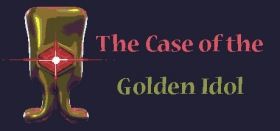
So I Tried... The Case of the Golden Idol
Each edition of So I Tried… I will try a game that I have never played before. Will I find something new to love? Will I find something new to despise? I’ll take a full half hour, no matter how bad it gets or how badly I do, to see if this is the game for me. This time, I became an 18th-century detective in The Case of the Golden Idol, a point-and-click puzzler from Color Gray Games.
What I Thought It Was

The Case of the Golden Idol has been on my radar for nearly a year now. Friends have recommended it to me as a one-of-a-kind detective game, and from what I’ve seen of its overwhelmingly positive Steam reviews, the puzzles are top-notch and rather difficult. By some miracle, that’s pretty much all I’ve heard. So, I was still able to go into this playthrough with little knowledge of the mechanics and story. However, I did expect to see hallmarks of the whodunit genre, with plenty of suspects and clues to connect as we solve the game’s 12 deaths.
What It Actually Is

Set in the 18th century, The Case of the Golden Idol has you solving murders that take place across a 50-year time span, all of which are connected to the titular golden idol. Though I’ve only played through four of the deaths thus far, it’s already clear that this tiny mysterious statue is very powerful, so much so that these people will lie, steal, and kill for it.
When it comes to investigating, you’re not necessarily a detective who’s knocking on the door of a suspect days or weeks after a crime was committed. Instead, you’re dropped right into the middle of a murder — like a guy actively being pushed off a cliff or someone bursting into flames — or the scene might take place shortly after, with the corpse still relatively fresh.

You’re given two modes for interacting with a scene: Exploration and Thinking. In Exploration, you’ll point and click on objects and characters to gather clues. While most names and notable items (like possible murder weapons) will be added to your evidence bar at the bottom of your screen, you’ll still want to make a note of anything that stands out to you, as your observation skills are key to solving these mysteries. For example, a schedule listing stable duties and job rotations might seem mundane at first, but that information might be the way to uncover the identity of your victim.
Once you’ve gathered all the clues you need, you’ll switch over to Thinking, which brings you to a fill-in-the-blank scroll where you’ll drag and drop your evidence into the right spots, filling out character identities and piecing together the chain of events that led to the murder in the first place. It’s essentially a detective’s red-stringed corkboard but in Mad Libs form, which is pretty innovative and fun to fill out.
Will I Keep Playing?

That’s a big: Absolutely! I’m really enjoying how The Case of the Golden Idol motivates me to think deeply about the scene at hand, and it’s extremely easy to get sucked into each case as I repeatedly scour scenarios for small details. So far, I’ve had to note which rooms people were staying in, what type of attire a Lord was wearing when he died, which patrons were playing cards at a certain time, and more. As the difficulty ramps up, I’m looking forward to juggling even more clues and continuing the flip-flop of feeling dumb one moment and like a master sleuth the next.
I was also pleasantly surprised at how intriguing the characters and story have been. I’m already curious to see where this golden idol leads them, although it’s likely a path that dead-ends at the unyielding tip of a sword.







COMMENTS